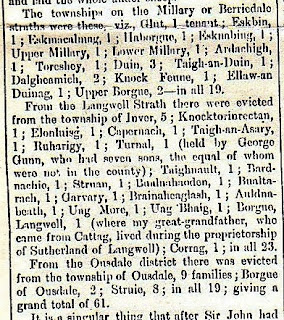This article written by Alexander Gunn was published in the
Northern Ensign on 27 March 1884
Since his statement to the Commission, the next
correspondence I have from Alexander Gunn is the letter below re evictions. I
have already published this letter way back on 20 November 2013 but to keep
continuity with Gunn’s letters I will publish it again without comment and
refer readers back to the 20 November 2013 blog for more details.
EVICTIONS
IN BERRIEDALE BY SIR JOHN SINCLAIR
To the
Editor of the Northern Ensign
 |
| Sir John Sinclair in Thurso |
SIR, -
Allow me through your valuable columns, to give a detailed account of the
evictions in Berriedale, both by Sir John Sinclair and by Mr James Horne, his
successor. The account of the matter by your correspondent, “Old Man Narrator,”
is not altogether correct. Sir John Sinclair, who was considered the greatest
agriculturist in the country, and who was a real or honorary member of almost
every agricultural society in the three kingdoms, as well as of several
societies on the continent of Europe, was the first to introduce what were
called the “big sheep” to Caithness. The small sheep or “Kerry,” was the only
breed in the country before that time. To make room for his sheep, Sir John
evicted 61 families from the Berriedale straths, and laid the whole under
sheep.
The
townships on the Millary or Berriedale straths were these, viz., Glut,1 tenant;
Eskbin,1; Eskmaealmag,1; Haborgue,1; Esknabing,1; Upper Millary,1; Lower
Millary,1; Ardachigh,1; Toreshey,1; Duin 3; Taigh-an-Duin,1; Dalgheamich,2;
Knock Feune,1; Ellaw-an Duinag,1; Upper Borgue,2 – in all 19.
From the
Langwell Strath there were evicted from the township of Inver,5;
Knocktorinrectan,1; Elonluisg,1; Capernach,1; Taigh-an-Asary,1;
Ruharigy,1; Turnal,1 (held by George Gunn who had seven sons, the equal
of whom were not in the country); Taighnault,1; Bardnachie,1;
Struan,1; Bualnahaoden,1; Bualtarach,1; Garvary,1;
Brainaheaglash,1; Auldnabeath,1; Uag More 1; Uag Bhaig,1;
Borgue, Langwell,1 (where my great-grandfather, who came from Cattag, lived
during the proprietorship of Sutherland of Langwell); Corrag,1; in all
23.
From the
Ousdale district there were evicted from the township of Ousdale, 9 families:
Borgue of Ousdale, 2; Struie, 8; in all 19; giving a grand total of 61.
It is
singular that after Sir John had turned out these 61 families, and occupied
their places with his sheep, he began to break up large tracks of ground on the
hill-side to the west of Berriedale, at a place called Carterfield, and got it
under cultivation, having taken several crops of oats off it. Also at Borgue,
Langwell, he brought in a large park, the first turf of which was cut by Lady
Janet, and was known ever after as Park-na-Bainthighearn, or “Her Ladyship’s
Park.” There was also broken up a large square piece of moor, or moss, to the
west of Carterfield. It was planted with curly greens about Christmas, and, as
might be expected, the frosts of winter destroyed every plant of them. These
fields which were broken up and put under crop for a year or two, instead of
being given to the tenants evicted from the straths, were allowed to fall out
of cultivation into grazings for sheep, and a few years saw them covered with
their original heather.
The
singular thing is that while by all accounts the Ulbster family have been the
most extensive evictors in the country, as appears from the recent
correspondence in your spirited paper, they were yet looked up to and esteemed
by the whole community. No doubt there were some good traits in their
character, but these were sullied and tarnished by their treatment of those
respectable and happy families that were so ruthlessly driven out of their
comfortable holdings. As stated in some of my previous communications, when Sir
John got his regiment of Fencibles embodied, he got 60 men from Berriedale,
said to be the finest men in the regiment, and yet this was the treatment they
received at his hands.
Your
correspondent is also at fault in saying that James Horne evicted none at
Berriedale. Horne evicted 13 families in the township of Auchencraig. Three
families were evicted by him from the Cairn, 4 from Rinsary, and 6 from Badbea.
True, some of these as your correspondent says, got miserable patches elsewhere
on the estate, but so did some of those evicted by Sir John; but I consider
they were entitled to be numbered among the evicted nevertheless, as they were
driven from their comfortable homes without justice or reason, and the plots on
which they were allowed to settle down were not entitled to the name of land,
being bare rocks or black moss, whilst the arable land they were driven from
was given over for sheep grazings.
The
Ulster family may well pray to be saved from their friends, since Mr Logan, who
shows great zeal on their behalf , has been the means of bringing to light
matters that had been entirely forgotten, and which would never appeared before
the public but for Mr Logan’s zeal without knowledge. I would venture to give
him a bit of advice for his guidance in the future, and that is let sleeping
dogs lie. – Yours &c.,
Alex
Gunn. Glasgow











